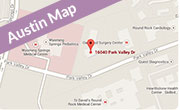Embryo grading is a tool to help our Austin IVF lab tell the best embryos to transfer during an IVF cycle.
Embryo grading is a tool. It is a tool that the physicians and embryologists at our Austin IVF lab use along with a patient’s age, history and other information to determine the day of transfer, number of embryos to transfer and which embryos to transfer.
On day 5 embryos are continuing to divide and the number of cells continues to increase, but they are also growing and differentiating into specific cell types. By this time embryos should have started to outgrow the space inside the zona pellucida (ZP or “egg shell”) that contained the egg. They start to expand and thin the ZP in preparation for hatching and implantation into the uterine lining. There are two cell types in the day 5 embryo or blastocyst. One cell type is called the Inner Cell Mass (ICM). This ball of cells will eventually grow into the fetus. The other cell type is the Trophectoderm Epithelium (TE). This sheet of cells will go on to make tissues needed during pregnancy (like the placenta). Together these cell types make a fluid filled sphere with the TE cells on the outside and the ICM inside.
Think of a balloon. If you blow up a balloon and put a ping-pong ball inside, that is what a blastocyst looks like. The latex of the balloon is the TE and the ping-pong ball is the ICM. Both of these cell types are necessary to establish a healthy pregnancy. You cannot have a baby without a placenta and you cannot have a pregnancy without a fetus, so when we grade embryos at the blastocyst stage, we assign a letter grade to each of the cell types as well as to the fluid filled cavity or blastocoel. We also assign a grade to designate how much the embryo is expanded (this relates to how large the blastocoel is as well as how many cells are contained in the embryo).
Examples of the expansion grades are: Very Early Blastocyst, in which the cavity is just beginning to form in the embryo and the cell types are not yet distinguishable; Expanded Blastocyst, in which the cavity is fully formed, the embryo contains 100 to 125 cells, but is still contained within the thinned ZP; Hatched Blastocyst, in which the embryo is outside of the ZP, and contains upwards of 150 cells. Below are some examples of embryos that our Austin IVF lab typically sees on day 5.
| Expanding Blastocyst (DC) | 50-75 cells, Developing ICM, growing trophectoderm, clear blastocoel | |
| Expanded Blastocyst (CB) | 100-125 cells, compacted, good quality ICM, nicely populated trophectoderm, clear blastocoel | |
| HatchingBlastocyst (BB) | 100-125 cells with trophectoderm beginning to protrude outside of the zona pellucida, good quality ICM, nicely populated trophectoderm, clear blastocoel | |
| Expanding Blastocyst (BB) | 50-75 cells, good quality ICM, nicely populated trophectoderm, clear blastocoel | |
| HatchingBlastocyst (AB) | 100-125 cells with trophectoderm beginning to protrude outside of the zona pellucida, large, good quality ICM, nicely populated trophectoderm, clear blastocoel |
As you might notice from the examples above, blastocyst grading is complex and therefore there are no absolute grades. While an A is “better” than a D, an embryo with a D ICM, for example, may be still developing and when viewed later, the ICM will have compacted into a B or an A. Many times a Very Early Blastocyst on Day 5 is an Expanded Blastocyst on Day 6 and can be frozen if the other indicators are also good. The determination of whether an embryo has good potential or not is based taking all of the components of the embryo together.
Embryo grading is a tool. It is a tool that the physicians and our Austin IVF lab embryologists use along with a patient’s age, history and other information to determine the day of transfer, number of embryos to transfer and which embryos to transfer.

